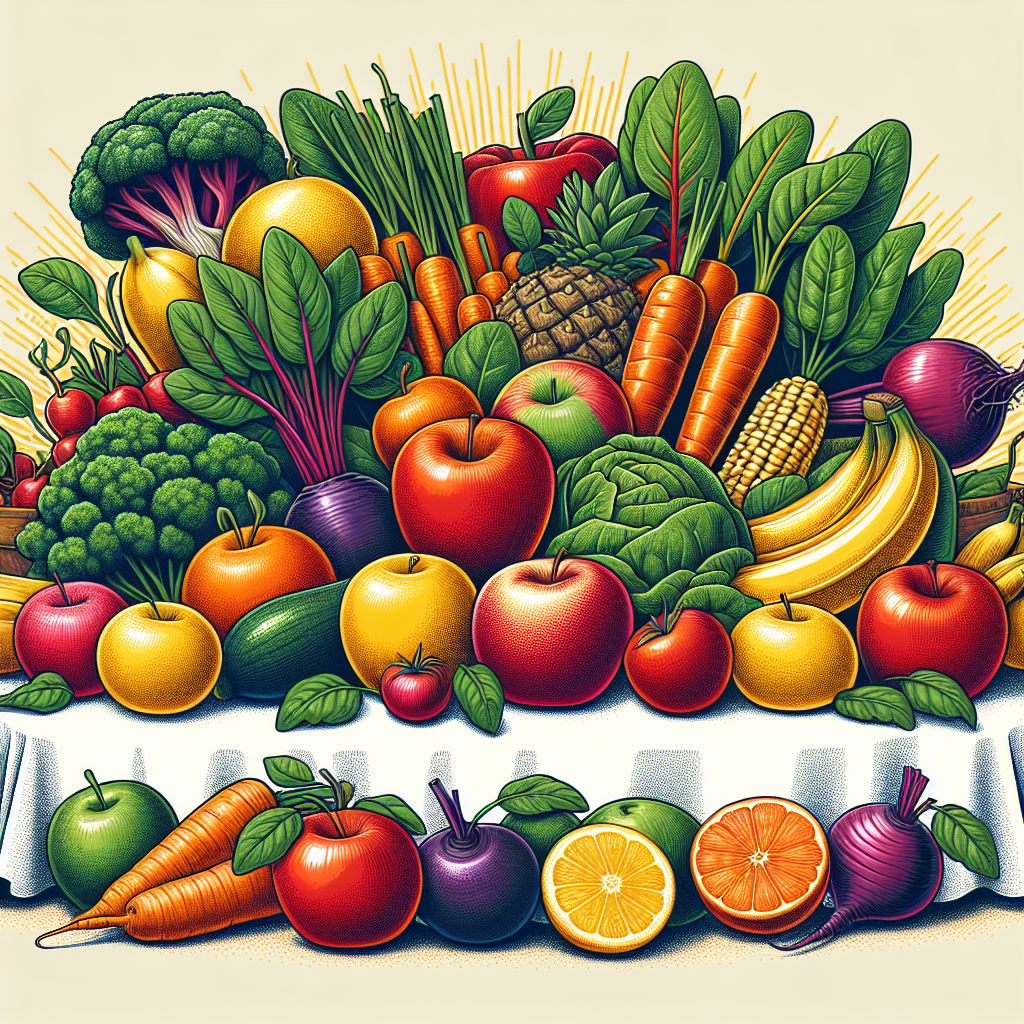Are you curious about the role that fruits and vegetables play in preventing cancer? Look no further! In this article, we will explore the dietary guidelines for cancer prevention and focus specifically on the amazing benefits that these colorful and nutrient-rich foods can provide. From reducing the risk of certain types of cancer to promoting overall health and well-being, incorporating fruits and vegetables into your diet is a small but powerful step that can make a big difference in your long-term health. So, let’s dive right in and learn more about the amazing ways in which these natural wonders can protect and empower your body!
Benefits of fruits and vegetables
Eating a diet rich in fruits and vegetables is essential for maintaining good health and preventing various diseases. Fruits and vegetables provide numerous nutritional benefits, including vitamins, minerals, and dietary fiber. They are also excellent sources of antioxidants and phytochemicals, which help protect the body against harmful free radicals. Moreover, incorporating fruits and vegetables in your diet can support weight management and reduce the risk of chronic diseases like cancer, heart disease, and obesity.
Nutritional value of fruits and vegetables
Fruits and vegetables are packed with essential nutrients that are vital for the proper functioning of the body. They contain a wide range of vitamins, such as vitamin A, vitamin C, vitamin K, and folate. These vitamins play crucial roles in maintaining healthy skin, boosting the immune system, promoting blood clotting, and supporting cell growth and development.
Moreover, fruits and vegetables are also rich in minerals like potassium, magnesium, and calcium. These minerals contribute to maintaining healthy bones, regulating blood pressure, and supporting muscle function. Including a variety of fruits and vegetables in your diet ensures that you receive a wide array of nutrients to meet your body’s needs.
Antioxidants and phytochemicals
One of the key benefits of fruits and vegetables is their high antioxidant content. Antioxidants are substances that help protect the body against oxidative stress and minimize damage caused by free radicals. Free radicals are unstable molecules that can lead to cell damage and increase the risk of chronic diseases.
Fruits and vegetables contain various types of antioxidants, including vitamin C, vitamin E, flavonoids, and carotenoids. These antioxidants work synergistically to neutralize free radicals and reduce the risk of oxidative damage to cells and tissues. By including a variety of colorful fruits and vegetables in your diet, you can maximize your intake of antioxidants and improve overall health.
Fiber content
Fruits and vegetables are excellent sources of dietary fiber, which is important for maintaining a healthy digestive system and preventing constipation. Fiber adds bulk to the diet, helping to regulate bowel movements and promote optimal digestion. It also aids in weight management by providing a feeling of fullness and helping to control calorie intake.
Additionally, dietary fiber helps maintain stable blood sugar levels and may reduce the risk of developing type 2 diabetes. It also contributes to heart health by lowering cholesterol levels and reducing the risk of heart disease. Including fiber-rich fruits and vegetables in your meals and snacks can help you meet your daily fiber requirements and enjoy these associated health benefits.
Recommended daily intake of fruits and vegetables
To gain the maximum health benefits from fruits and vegetables, it is important to consume them in adequate amounts on a daily basis. The recommended daily intake of fruits and vegetables may vary depending on factors such as age, sex, and level of physical activity. However, there are general guidelines and specific recommendations for different age groups that can help you ensure you’re getting enough of these nutritious foods.
General guidelines
The general guideline for adults is to consume at least 2 cups of fruits and 2.5 cups of vegetables per day. This recommendation is based on a 2,000-calorie diet and can be adjusted according to individual energy needs. It is important to note that these recommendations serve as a minimum, and individuals are encouraged to consume even higher quantities of fruits and vegetables for optimal health benefits.
Specific recommendations for different age groups
For children aged 1-8 years, the recommended daily intake of fruits and vegetables depends on their energy needs, which gradually increase as they grow. On average, children in this age group should consume 1.5-2 cups of fruits and 1.5-2.5 cups of vegetables per day.
For adolescents aged 9-18 years, the recommended daily intake increases to 1.5 cups of fruits and 2-3 cups of vegetables. It is important to encourage teenagers to include a variety of fruits and vegetables in their diet to ensure they obtain a wide range of essential nutrients.
Adults aged 19-50 years, including pregnant and lactating women, should consume at least 2 cups of fruits and 2.5 cups of vegetables daily. For adults aged 51 years and older, the recommended daily intake remains the same.
By following these recommendations and adjusting them to individual needs, you can ensure you are incorporating an adequate amount of fruits and vegetables into your diet.

Types of fruits and vegetables to focus on
Not all fruits and vegetables are created equal when it comes to their nutritional value and health benefits. Some types of fruits and vegetables offer more nutritional value than others. By focusing on specific categories, you can ensure you are maximizing the health benefits you receive from these foods.
Colorful fruits and vegetables
Including a variety of colorful fruits and vegetables in your diet can provide a wide range of nutrients and health-promoting compounds. Different colors indicate different phytochemicals, which have unique properties and health benefits. For example, orange and yellow fruits and vegetables, such as carrots and oranges, are high in beta-carotene, which is converted into vitamin A in the body and supports eye health and immune function.
Red fruits and vegetables, such as tomatoes and red peppers, contain lycopene, a powerful antioxidant that may reduce the risk of certain types of cancer and promote heart health. Green leafy vegetables, like spinach and kale, are packed with vitamins A, C, and K, as well as folate and fiber.
By including a variety of colorful fruits and vegetables in your diet, you can ensure a diverse intake of beneficial nutrients and compounds.
Leafy greens
Leafy greens are nutritional powerhouses that should be a regular part of your diet. They are rich in vitamins, minerals, and fiber while being low in calories. Leafy greens, such as spinach, kale, Swiss chard, and romaine lettuce, are excellent sources of vitamin K, which plays a vital role in blood clotting and bone health.
They are also high in folate, a B vitamin essential for cell growth and development, and vitamin C, which supports immune function and collagen production. Moreover, leafy greens are packed with antioxidants and phytochemicals that have been linked to a reduced risk of chronic diseases like cancer and heart disease.
Cruciferous vegetables
Cruciferous vegetables belong to the Brassicaceae family and include vegetables such as broccoli, cauliflower, cabbage, Brussels sprouts, and kale. These vegetables are known for their unique taste, texture, and health benefits. They contain a compound called glucosinolates, which are broken down into compounds like indoles and isothiocyanates during digestion.
These compounds have been found to have anti-cancer properties and may help prevent the development of certain types of cancer, including lung, colorectal, and breast cancer. Cruciferous vegetables are also high in fiber and antioxidants, making them an excellent addition to a balanced diet.
Berries
Berries are not only delicious but also incredibly nutritious. They are packed with vitamins, minerals, antioxidants, and fiber. Berries, such as blueberries, strawberries, raspberries, and blackberries, are particularly rich in antioxidants like anthocyanins, which have been associated with numerous health benefits.
These antioxidants help reduce inflammation, protect against cellular damage, and support brain health. Berries are also relatively low in calories and high in fiber, making them a great option for those watching their weight or managing blood sugar levels.
Citrus fruits
Citrus fruits, including oranges, lemons, grapefruits, and limes, are not only refreshing but also provide a significant nutritional boost. They are packed with vitamin C, which is essential for immune function, collagen production, and wound healing. Citrus fruits also contain other vitamins and minerals, such as potassium and folate.
Additionally, citrus fruits are high in antioxidants that help protect against cellular damage and reduce the risk of chronic diseases like heart disease and cancer. Incorporating citrus fruits into your diet can provide a delicious and nutritious way to meet your recommended daily intake of fruits.
Preparing and cooking fruits and vegetables
How you prepare and cook fruits and vegetables can greatly impact their nutritional value and taste. Here are some tips on different cooking methods to preserve nutrients and enhance flavor.
Raw vs cooked
Both raw and cooked fruits and vegetables offer nutritional benefits, and incorporating a combination of both in your diet is ideal. Raw fruits and vegetables are most beneficial for preserving heat-sensitive nutrients like vitamin C and certain enzymes. On the other hand, cooking can enhance the bioavailability of certain nutrients, such as beta-carotene in carrots and lycopene in tomatoes.
Steaming and boiling
Steaming and boiling are popular cooking methods that help retain the nutrients in fruits and vegetables. Steaming involves using steam to cook the food, while boiling involves immersing the food in boiling water. These methods allow the fruits and vegetables to cook until tender, preserving their natural flavors and essential nutrients. Avoid overcooking to prevent nutrient loss.
Grilling and roasting
Grilling and roasting are dry heat cooking methods that can add flavor and texture to fruits and vegetables. Grilling involves cooking the food over an open flame or hot coals, while roasting involves cooking in an oven at high temperatures. These methods can enhance the natural sweetness and caramelization of fruits and vegetables, making them more appealing and flavorful.
Avoiding excessive oil and salt
When preparing fruits and vegetables, it is important to avoid excessive use of oil and salt. While a small amount of oil can enhance the absorption of fat-soluble vitamins, using too much oil can contribute to excess calories and negate the health benefits of these foods. Similarly, excessive salt intake can lead to high blood pressure and other health issues. Instead, focus on using herbs, spices, and other flavoring agents to enhance the taste of fruits and vegetables without adding unnecessary calories or sodium.

Incorporating fruits and vegetables in your diet
To reap the maximum benefits of fruits and vegetables, it is important to incorporate them into your daily meals and snacks. Here are some tips on how to make this a seamless and enjoyable part of your diet.
Replacing unhealthy snacks with fruits and vegetables
A simple yet effective way to include more fruits and vegetables in your diet is to replace unhealthy snacks with healthier options. Instead of reaching for a bag of chips or a candy bar, opt for a piece of fruit or some sliced vegetables with a nutritious dip like hummus or guacamole. Not only will these snacks provide valuable nutrients, but they will also help satisfy cravings and contribute to your overall health goals.
Including fruits and vegetables in every meal
Another way to increase your fruit and vegetable intake is to strive to include them in every meal. Whether it’s adding berries to your breakfast cereal, including a side salad with your lunch, or incorporating grilled vegetables into your dinner, make it a habit to fill your plate with colorful and nutritious ingredients. This will not only enhance the taste and variety of your meals but also provide you with the necessary vitamins and minerals to support optimal health.
Experimenting with new recipes and combinations
To keep things interesting and prevent boredom, explore different recipes and combinations of fruits and vegetables. Try new cooking techniques, experiment with various herbs and spices, and mix different fruits and vegetables to create tasty and nutritious dishes. By being adventurous in the kitchen, you can discover new flavors and textures that will make eating fruits and vegetables an enjoyable experience.
Benefits of organic fruits and vegetables
While consuming any fruits and vegetables is beneficial for your health, opting for organic varieties can provide extra advantages. Organic farming practices prohibit the use of synthetic pesticides, fertilizers, genetically modified organisms, and growth hormones. Here are some key benefits of organic fruits and vegetables.
Lower pesticide exposure
One of the primary advantages of organic fruits and vegetables is minimized exposure to pesticides. Conventionally grown produce may contain traces of synthetic pesticides, which have been associated with various health concerns. By choosing organic options, you can reduce your exposure to these chemicals and lower the potential risks associated with pesticide residues.
Higher nutrient content
Some studies suggest that organic fruits and vegetables may have higher nutrient content compared to conventionally grown produce. Soil quality and farming practices used in organic agriculture can contribute to greater levels of certain vitamins, minerals, and antioxidants. While the differences may be minor, opting for organic varieties can offer an additional nutritional boost.
Supporting sustainable farming practices
Organic farming practices prioritize sustainability and environmental preservation. By choosing organic fruits and vegetables, you are supporting farmers who use methods that promote soil health, conserve water and energy, and protect biodiversity. It is a way to contribute to a more sustainable food system and reduce the environmental impact of agriculture.

Fruits and vegetables for cancer prevention
Including a variety of fruits and vegetables in your diet can play a crucial role in reducing the risk of various types of cancer. Here are some ways in which fruits and vegetables contribute to cancer prevention.
Reducing the risk of various types of cancer
Numerous studies have shown that high consumption of fruits and vegetables is associated with a decreased risk of certain types of cancer. The presence of antioxidants, phytochemicals, and fiber in these foods helps neutralize free radicals, reduce inflammation, and protect DNA from damage. By incorporating a wide range of fruits and vegetables into your diet, you can provide your body with the necessary nutrients and compounds for cancer prevention.
Anti-inflammatory properties
Chronic inflammation is known to contribute to the development and progression of cancer. Fruits and vegetables are naturally high in anti-inflammatory compounds, such as polyphenols and carotenoids, which can help reduce inflammation in the body. Eating a variety of colorful fruits and vegetables can support a healthy inflammatory response and potentially lower the risk of cancer.
Detoxification and immune system support
Certain fruits and vegetables, especially cruciferous vegetables and berries, have been found to have detoxification and immune system-boosting properties. The compounds present in these foods can help support the body’s natural detoxification processes, eliminate harmful substances, and enhance immune function. By including these foods in your diet, you can support your body’s ability to prevent and combat cancer.
Fruits and vegetables as part of a balanced diet
While fruits and vegetables provide numerous health benefits, it is important to consume them as part of a well-balanced diet. Here are some considerations to keep in mind when incorporating fruits and vegetables into your meals.
Balancing macronutrients
Fruits and vegetables are excellent sources of vitamins, minerals, and fiber, but they may not provide sufficient amounts of macronutrients like protein and healthy fats. To ensure a balanced diet, it is important to include other sources of protein, such as lean meats, fish, legumes, and dairy products. Healthy fats can be obtained from sources like avocados, nuts, seeds, and olive oil. Combining fruits and vegetables with these macronutrients will create a well-rounded meal that supports overall health.
Portion control
Although fruits and vegetables are highly nutritious, it is still important to practice portion control to maintain a balanced diet. While there are no strict rules for portion sizes, a general guideline is to fill half of your plate with fruits and vegetables, with the other half allocated for protein and whole grains. This approach ensures that you are getting a good balance of nutrients and calories.
Healthy snacking options
Fruits and vegetables make excellent choices for healthy snacking between meals. Keep a variety of fresh fruits and cut-up vegetables nearby for when hunger strikes. This way, you can satisfy your cravings without resorting to less healthy options. Dipping sliced vegetables in hummus or enjoying a piece of fruit with a side of yogurt are nutritious and satisfying snack choices.

Potential challenges and solutions
Incorporating more fruits and vegetables into your diet can come with certain challenges. However, with a little planning and creativity, these challenges can be overcome.
Cost and accessibility
One common challenge is the cost and accessibility of fresh fruits and vegetables. To address this, consider purchasing seasonal produce, as it is often more affordable and readily available. Exploring local farmers’ markets or joining a community-supported agriculture (CSA) program can also provide access to fresh and locally grown fruits and vegetables at reasonable prices. Additionally, frozen and canned fruits and vegetables are convenient options that retain many essential nutrients and can be more affordable.
Food preparation time
Another challenge is finding the time to prepare and cook fruits and vegetables. To overcome this, consider prepping and chopping fruits and vegetables in advance during your free time. This will make it easier to incorporate them into meals and snacks throughout the week. Additionally, using time-saving cooking methods like steaming, stir-frying, or roasting can significantly reduce cooking times while still preserving their nutritional value.
Picky eaters
If you or your family members are picky eaters, introducing new fruits and vegetables into your diet may be challenging. Start by gradually incorporating small portions of different types of fruits and vegetables into meals. Blend vegetables into smoothies or soups, and incorporate fruits into desserts or breakfast dishes. It may take some time for taste buds to adjust, but with persistence and patience, new preferences may develop.
Conclusion
Incorporating fruits and vegetables into your daily diet offers numerous health benefits. They are rich in essential nutrients, antioxidants, and fiber, which can support overall health and reduce the risk of chronic diseases. By following general guidelines and specific recommendations for different age groups, you can ensure you are getting the recommended daily intake of fruits and vegetables.
Focus on colorful fruits and vegetables, leafy greens, cruciferous vegetables, berries, and citrus fruits to maximize nutritional benefits. Experiment with different cooking methods while being mindful of excessive oil and salt to preserve nutrients and enhance flavor. Replace unhealthy snacks with fruits and vegetables, include them in every meal, and try new recipes and combinations to make the consumption of fruits and vegetables enjoyable.
Opting for organic fruits and vegetables can further reduce pesticide exposure, provide higher nutrient content, and support sustainable farming practices. These wholesome foods also play a vital role in cancer prevention, thanks to their anti-inflammatory properties and ability to support detoxification and immune system function.
Remember to balance macronutrients, practice portion control, and consider fruits and vegetables as healthy snack options. Overcoming challenges such as cost, accessibility, food preparation time, and picky eaters can be achieved with planning and creativity. By taking action to incorporate fruits and vegetables into your diet, you are making a conscious effort towards better health and overall well-being.


